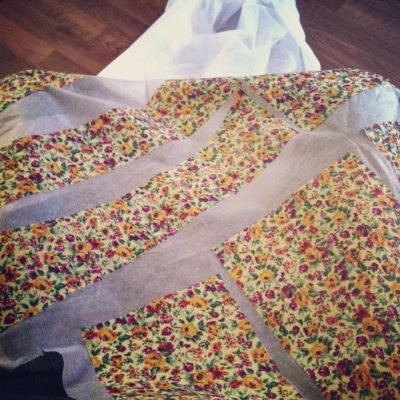Editor's Note: This blog post was written by Swoon Patterns founder/designer in 2014. The types of interfacings and stabilisers available and our team's recommendations as to which types to use have changed over the years. A more recent guide to interfacings and stabilisers can be found on our sibling brand's YouTube channel here: 'Interfacing and Stabilisers for Bagmaking'
Common Interfacings Used in (Swoon) Bags
- written by Alicia Miller, 21st November 2014
The majority of questions I get are about interfacing so I wanted to take a moment and talk about the ones I use/recommend and why. All of these should be easily found in your fabric store, look for all the white bolts stacked together. I use all Pellon products, but feel free to substitute with other brands based on the description. What interfacing one person might love, another may dislike. So get a few types and play around with them, trial and error is the best way to learn what works for you.

Pellon Peltex 71f (Fusible Stabilizer)
This is the stiffest of the fusible stabilizers and great for making bags that need to hold their shape and have a nice heavy quality feel. It feels like a stiff dense felt. Due to the thickness, the seam allowance should be trimmed off the pieces before fusing and you won’t actually sew through it. It’s expensive ($8 a yard) and can be difficult to sew into a bag but the end product is worth the trouble, it can be laundered and holds its shape very well over time. When fusing to quilting weight fabric, the fabric can take on a slightly bumpy appearance. It works well alone fused to home décor weight.
To completely get rid of the “bumpy fused” look, instead use sew-in Peltex 70. Trim the seam allowance off of each panel, then place it against the wrong side of the exterior fabric. Then cover with Shapeflex SF101 and fuse the seam allowance to the exterior, holding the Peltex in place.
A great Peltex substitute I’ve recently discovered is Stiffy (yes, Stiffy…) from Long Creek Mills. Not only is it inexpensive ($42 for a 35 yard roll), it’s just a hair stiffer than Peltex AND is a small family-run company.
EU Replacement: Vilene Decovil / Decovil Light / S520
Pellon Craftfuse 808 (Fusible Stabilizer)
It’s much thinner than Peltex but when doubled up, can be just as stiff. It creases easier and can be a little crinkly-feeling, but is much cheaper ($2.50 a yard) and easier to sew than Peltex. Because it is thinner, you don’t need to trim off the seam allowances before fusing, and it’s cake to sew through. For applications that don’t need to be super stiff (like a bag lining), one layer of Craftfuse is perfect. For stiff bag exteriors, simply fuse two layers, one to the fabric, then another over top. I double up with Craftfuse when making the Dottie so it stays in its vintage 3D shape. Craftfuse is interchangeable with Decorbond 809.
EU Replacement: Vilene H250 / H200
Pellon Thermolam Plus (Fusible Fleece)
I use this lofty fusible fleece in bags that I don’t want to maintain a stiff shape, but want to have body, such as the Dallas Vintage Duffel. Think thin quilt batting. It’s easy to use, very light, and not too expensive considering it’s double the width of the other interfacings listed. It will hold some shape though, so don’t use for something you want to slouch. You can use regular Pellon Fusible Fleece as well. It’s a bit loftier than Thermolam, which has been needled and is denser. You can use this over Craftfuse/Decorbond to minimize the crinkliness (I doubt that’s a word).
EU Replacement: Vilene H640 / H630
Pellon ShapeFlex SF101 (Woven Fusible Interfacing)
For everything that doesn’t get the aforementioned interfacings (pockets, linings, etc.), I will use this interfacing. This is good for slouchy applications where no stiffness is needed, just more body and “bought in a store” crispness. Basically making a quilting weight more like a home decor weight. I use this for the entire India Hobo Bag.
EU Replacement: Vilene G700 / G707
Pellon Flex Foam 77 / ByAnnie’s Soft & Stable (Foam)
I was late to the game in trying foam interfacing because of availability, but once I did, I was hooked! This makes a nice structured bag that stands up on it’s own, yet is very easily manipulated unlike the stiffer stabilizers like Peltex. The pliability makes it a breeze to sew. It’s usually sew-in and not fusible, so you will have to either baste it to the exterior fabric pieces, or use a fusible web, like Pellon Wonder Under 805. The Flex Foam and Soft & Stable are nearly identical, but keep in mind Flex Foam is 20″ wide (around $5 a yard on sale) and Soft & Stable is 58″ wide (around $18 a yard). When you figure in the sale prices and widths, the costs are close enough to be negligible. Flex Foam is more accessible and sold at Joann Fabric stores by the yard. You can find Soft & Stable at small independent fabric stores as well as Amazon.com.
I hope this helps and always remember…
ONLY BUY INTERFACING WHEN IT’S ON SALE!